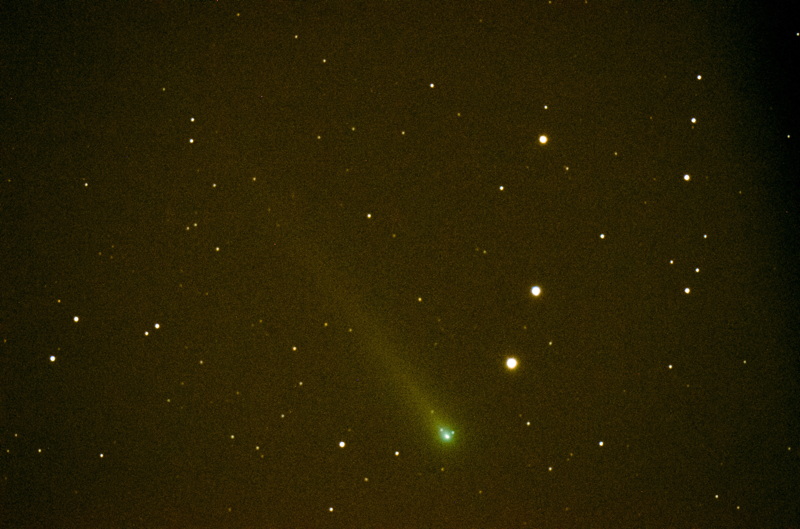
Night of the Comets: Lovejoy, ISON, Encke
Posted: 1 November 2013
Cassiopeia Observatory was opened Thursday, 31 October 2013, at 2248 MST, 50°F. The sky was clear. I opened up later than normal as I knew I would be up late to image three comets in the morning sky.
My first visual object was the Veil Nebula, 83X, at 2259 MST. It was just barely visible. Added a focal reducer and switched to a 40mm eyepiece (yielding 31X). The nebula was visible, but really became quite visible when I added an Oxygen-III filter. An even better view of the Veil Nebula was with a 26mm eyepiece + focal reducer (48X) + O-III filter. Without the filter the nebula was visible but not as easy a target. At 2312 MST, I noticed that M33 (Triangulum Galaxy, 2.8 Million Lightyears away) was near the zenith and easily seen with my naked eyes.
At 2320 MST, slewed to Rigel and SYNCed the AutoStar. Then went to M42 (Great Nebula in Orion). The view was super at 48X (no filter). I then slewed to the Horsehead Nebula, still low in the east. I could see nebulosity but no "horsehead". With the bright star Alnitak out of the field-of-view, I could see the Flame Nebula. Added a Hydrogen-Beta filter to the 26mm eyepiece; still no horsehead. Decided to wait until Orion was higher in the sky.
Took a quick look at Jupiter, 48X, low in the east at 2344 MST. The four Galilean Moons were visible, but seeing was bad (which could help explain why the Horsehead Nebula was not seen).
I then did a tour of some DSOs in Orion, 48X: NGC1977 (Running Man Nebula), M43 (nebula), NGC1990 (nebula), NGC2024 (Flame Nebula), M78 (nebula), and NGC2194 (open cluster). I then resumed trying to see the Horsehead Nebula. Added the H-β filter again. No luck. By 0040 MST, I could almost see the "horsehead" with and without the filter, but I was never quite certain. I removed the focal reducer and tried at 77X, with and without the H-β filter. Still no confirmation that I saw the "horsehead". I have seen it in the past with my 8" LX200-ACF so I know it is possible to see it.
Returned to Jupiter at 0051 MST, 77X and 206X. Seeing still not good. At 0102 MST, I slewed to Rigel and using 206X, checked the separation of its companion star, which is similar to the current separation of Sirius B from Sirius A. While waiting for Sirius to rise higher, I began preparing the D7000 DSLR for later imaging. Beginning at 0130 MST, I tried to view Sirius B using 206X and 364X. No success. I have seen it in the past, but not this night.
With the temperature at 48°F, I decided to take a short "warm up" break. Put the telescope to sleep and closed the dome at 0139 MST. I returned to the observatory at 0224 MST, 46°F.
Woke the telescope, slewed to the star Procyon, and SYNCed the AutoStar for comet GOTOs and imaging. Turned on the GC Wi-Fi Adapter and used SkySafari Pro on the iPhone 5s to GOTO to Comet C/2013 R1 (Lovejoy). At 83X, a large coma was visible but no tail. I mounted the D7000 DSLR at the 8" prime focus using an off-axis guider. Did a focus test on Procyon using the Bahtinov Mask, then went back to the comet, which was visible in the D7000 viewfinder. At 0249 MST, took this photo (full-frame) of Comet Lovejoy, 1 minute, unguided, ISO 6400:

This 5 minute, guided (on a star, not the comet), ISO 6400, photo (also full-frame) shows the large coma of Comet C/2013 R1 (Lovejoy):

At 0315 MST, slewed to Comet C/2012 S1 (ISON), which was about to rise over the hill to the east. It rose over the hill at 0345 MST. The eastern sky was showing some brightening, which was from the morning Zodiacal Light. The comet was not visible in the camera viewfinder, nor was I able to find any good guide star. I did some test framing exposures and at 0405 MST, took this unguided 2 minute, ISO 6400 photo (full-frame), edited to bring out the long tail:

I then began a wait for Comet 2P/Encke to rise over the hill to the east. The Zodiacal Light was very visible now. At 0441 MST, the comet was above the hill and visible in the camera viewfinder. No guide star was found. At 0505 MST, captured this image of Comet 2P/Encke, still low in the east, 2 minutes, ISO 6400 (full-frame):

I completed comet imaging at 0511 MST. At 0515 MST, viewed Comet 2P/Encke at 83X. A nice nucleus and coma was visible, but no tail was seen. I then slewed to Comet C/2012 S1 (ISON) and viewed it, 83X. It was still very faint (maybe +9-ish), with a small coma and a faint tail visible.
The observatory was closed at 0533 MST, 47°F.
Comments are welcome; use the Comments section below, or you can Email Me. Thanks.
Cassiopeia Observatory Home Page